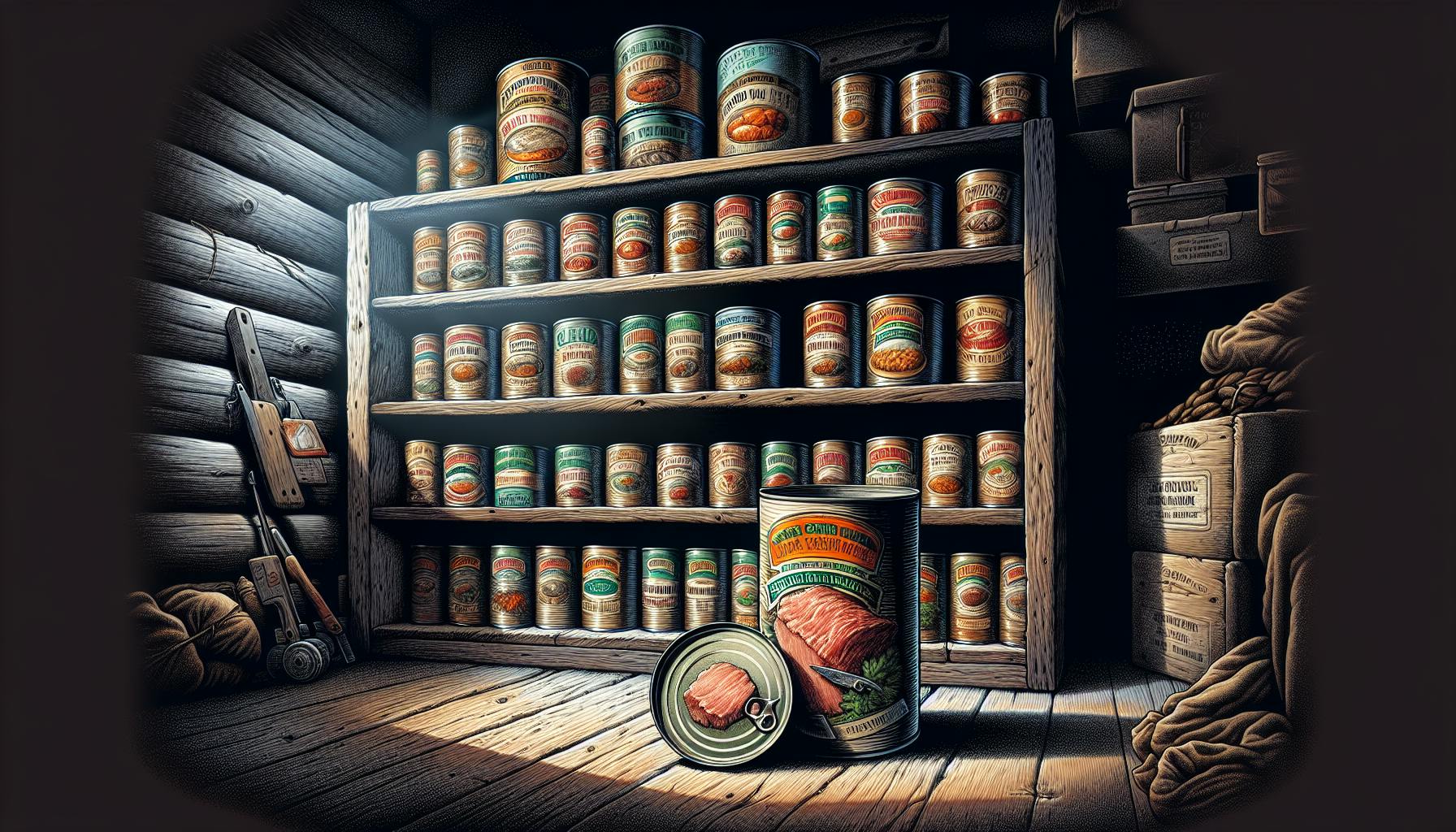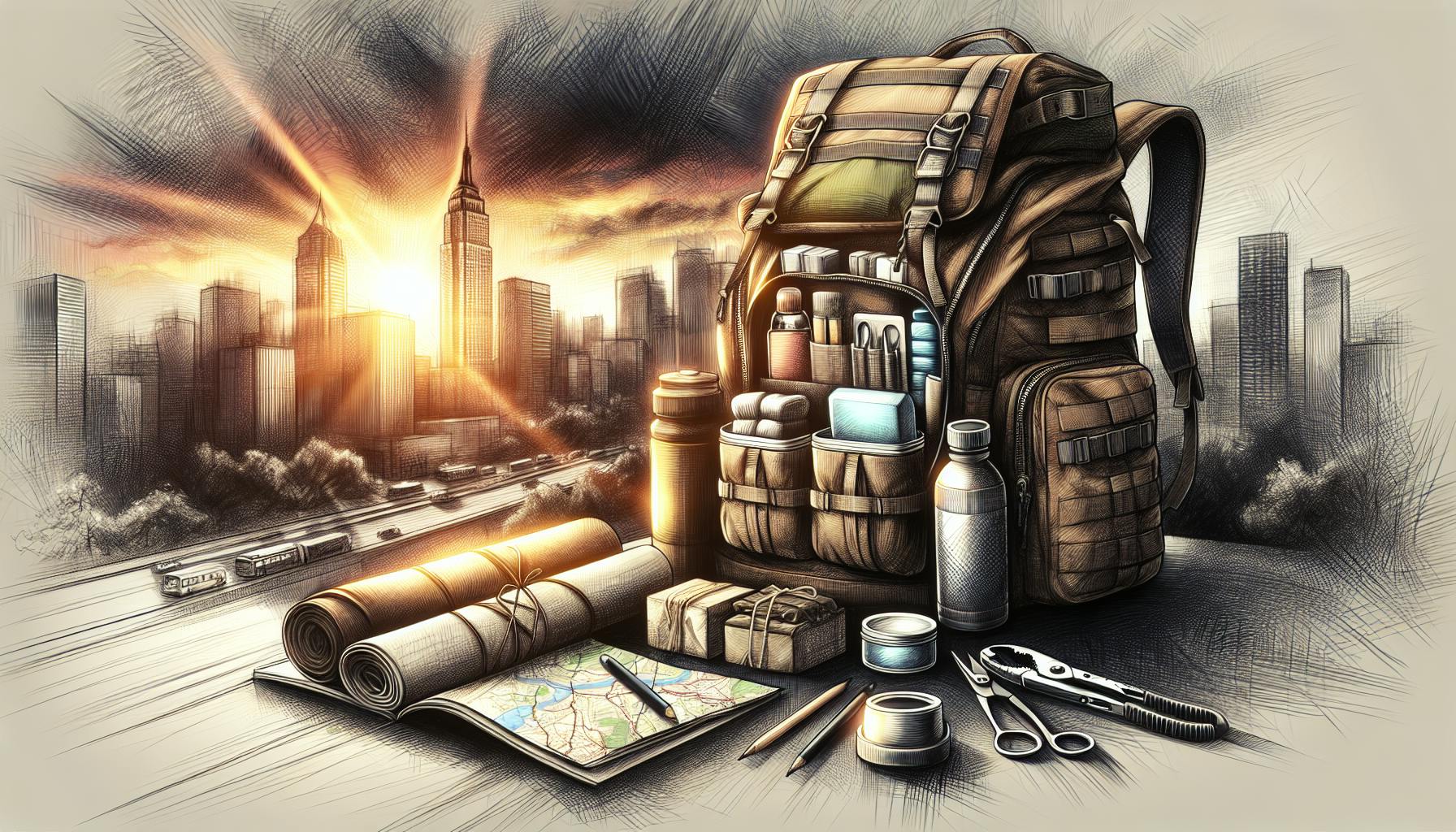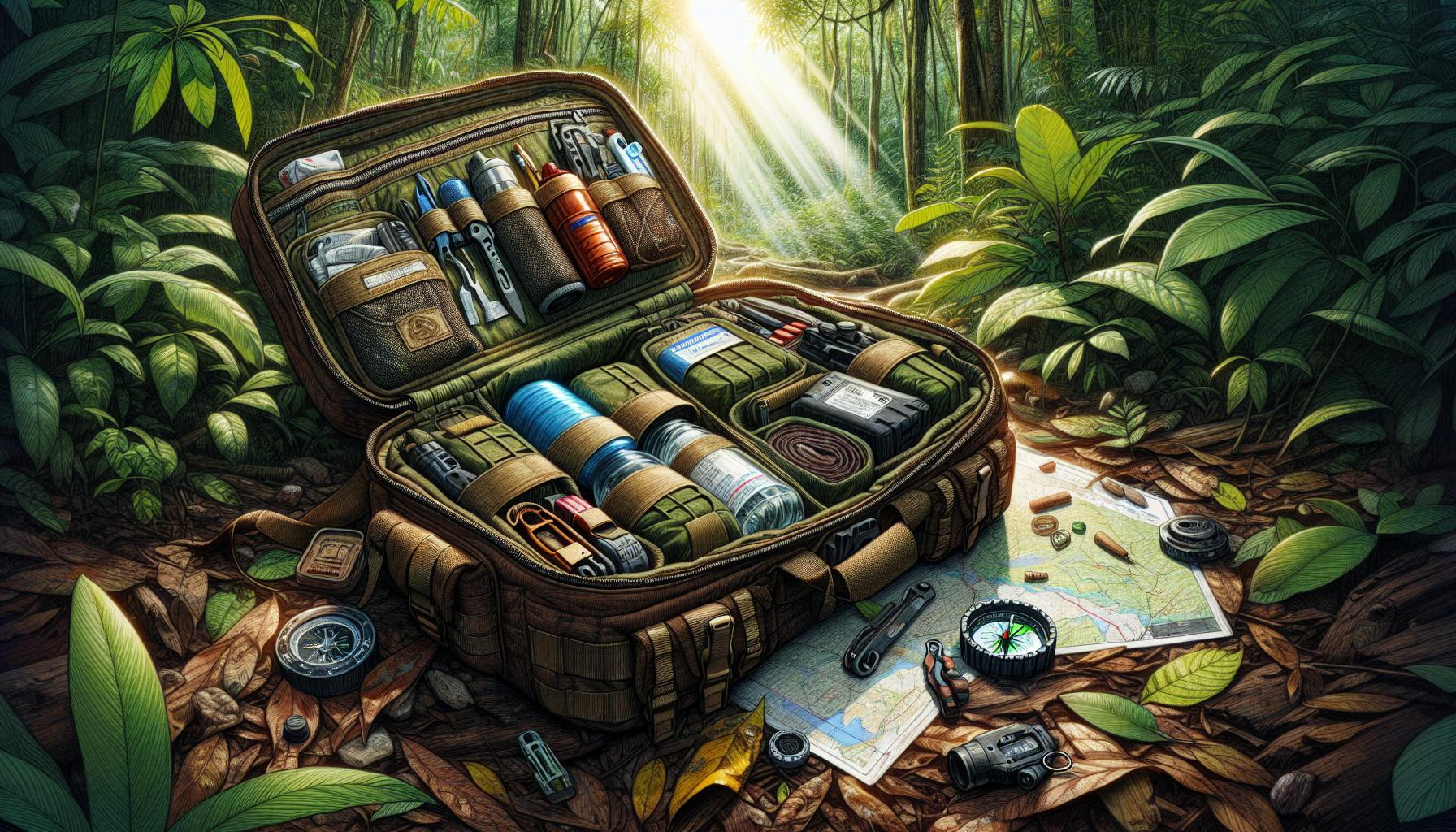When facing an emergency, we can all agree that access to clean drinking water is critical for survival.
Equipping yourself with a reliable survival water filter ensures you can transform contaminated water sources into potable water to sustain life in dire situations.
In this guide, we will explore the key features to look for when selecting the best survival water filter to meet your needs, from pore size to flow rate and contaminant removal capabilities. You'll also discover maintenance tips for preserving long-term filter effectiveness as well as top picks for wilderness, natural disaster preparedness, and portable filtration on-the-go.
The Critical Role of Survival Water Filters in Emergencies
A survival water filter is an essential piece of emergency preparedness gear. Having access to clean drinking water is vital in a crisis, and a good filter enables you to transform contaminated water from streams, ponds, and other sources into safe drinking water. When choosing a survival filter, key features to look for include portability, effectiveness at removing contaminants, and ease of use.
Understanding the Lifesaving Importance of Water Purification
Clean water is one of the most critical supplies to have on hand during an emergency. **Survival water filter**s allow you to avoid waterborne illnesses from bacteria, viruses, and parasites that can be present in found water sources after natural disasters or infrastructure breakdowns. Consuming contaminated water can lead to severe dehydration from diarrhea and vomiting, so a water filter is a lifesaving piece of any emergency preparedness kit.
Portable filters that rapidly purify significant volumes of water allow you to safely hydrate yourself and your family when normal water sources are compromised. Having an efficient way to make found water potable gives you resilience and reduces reliance on stored water reserves that are finite.
Criteria for Choosing the Best Survival Water Filter
When selecting a survival water filter for your emergency supplies, key criteria include:
- Portability: The filter should be lightweight and compact so it is easy to store and transport as part of your go-bag. Look for compact pump-style or straw-style filters.
- Effectiveness: Seek out filters that can remove bacteria, protozoa, viruses, and sediment using mechanical filtration combined with chemical treatment or UV light.
- Throughput: Aim for at least 125 gallons filtered before needing replacement filters to meet hydration needs in an extended crisis.
- Rapid flow rate: Look for units that can filter at least 1-2 liters per minute for quick access to purified water.
- Durability: Rugged housing and components that stand up to field use are vital.
Carefully choosing a filter that meets these criteria helps ensure you can safely access and purify water from uncertain field sources when you need it most. Pairing a quality survival filter with sufficient water storage gives you the resilience to face disasters.
Can you drink any water with LifeStraw?
LifeStraw's patented hollow fiber membrane water filter allows you to drink water safely from most freshwater sources. The filter removes 99.9999% of waterborne bacteria, 99.9% of waterborne protozoan parasites, and filters to 0.2 microns to remove microplastics, dirt, and cloudiness. This makes LifeStraw ideal for drinking from lakes, streams, ponds, and other outdoor water sources.
Some key things to know about drinking water with LifeStraw:
- It filters out harmful contaminants like giardia, cryptosporidium, and E. coli bacteria. This allows you to drink water that would otherwise make you sick.
- The filter will not remove chemicals, heavy metals, viruses, or salt from water. You should not drink seawater or chemically contaminated water.
- It filters up to 1,000 gallons of water over its lifetime. So you can keep using and reusing it.
- The straw itself has no moving parts or batteries. It works purely through the hollow fiber membrane.
- It's very portable at only 9 inches long and 1 inch around. Easy to toss in your backpack or emergency kit.
So while LifeStraw isn't a complete water purification solution, its simple filter allows you to drink fresh water from streams, ponds, rivers and more with peace of mind. The lack of chemicals or power requirements makes it a versatile choice for hiking, travel, emergency preparedness, and survival situations when you need access to safe drinking water on-the-go.
How do you make a survival water filter?
When in a survival situation without access to clean drinking water, being able to create a makeshift water filter can be critical. Here are some key steps to follow:
Gather Your Materials
You'll need a container like a bottle, pot, or can to collect the filtered water. You'll also need access to natural materials like sand, gravel, charcoal, and plant fibers that can filter contaminants.
Dig a Hole
Dig a hole in the ground a few inches deep and wide enough to place your container in. This will allow the water to collect after being filtered through the natural materials.
Layer Filtering Materials
Place filtering materials like sand, gravel, charcoal, and plant fibers in layers within the hole. The different sizes of the materials will filter out contaminants.
Cover the Hole
Cover the hole with a permeable material like a bandana or piece of plastic. This will allow water to pass through while keeping out debris.
Collect Water
Pour contaminated water onto the covered filter and allow it to pass through the layers of filtering materials. Collect the filtered water from your container.
Additional Tips
- Replace filtering material layers as they become clogged.
- Boil filtered water for added protection against pathogens.
- Use water purification tablets if available.
Having the knowledge and materials to construct a survival water filter can prove invaluable when access to clean water is limited. With some preparation, this simple but effective method can be lifesaving.
Is the LifeStraw water filter worth it?
The LifeStraw is a great option for a basic survival water filter. It's affordable, lightweight, and easy to use - you simply place one end in contaminated water and suck water through the filter. The LifeStraw removes bacteria, parasites, microplastics, and more from water sources.
The main benefits of the LifeStraw are:
- Portability: At just 2 oz, the LifeStraw is extremely lightweight and portable. It's an ideal choice for hiking, camping, or keeping in your emergency kit.
- Simplicity: With no moving parts or batteries, the LifeStraw requires no assembly or maintenance. You just sip directly from the filter.
- Affordability: The LifeStraw is very budget-friendly, typically retailing for around $20.
However, the LifeStraw does have some limitations to consider:
- It can't remove viruses from water. You'd need a filter with a chemical purifier for full protection.
- The flow rate is slow. It can take some effort to suck enough water through for hydration.
- It has a limited lifetime of water filtration. One LifeStraw will filter up to 1,000 gallons.
So is the LifeStraw worth it? If you want an inexpensive, simple way to filter water for survival situations, definitely. But if you'll rely on your water filter heavily or want maximum contaminant removal, other options like the Sawyer Squeeze or Survivor Filter may be better choices long-term.
Can you use a LifeStraw in the ocean?
No, LifeStraws are not designed to filter seawater. The LifeStraw utilizes a hollow fiber membrane that is specifically engineered to remove bacteria, parasites, microplastics, and other contaminants from fresh water. However, it does not remove salts or heavy metals.
If you tried to use a LifeStraw to drink seawater, the high salt concentration would quickly overwhelm and damage the filter fibers. While it may briefly remove some algae and microplastics as the seawater first passes through, it would not make the water safe to drink due to the remaining high salt levels.
Within a few minutes of exposure to seawater, a LifeStraw would become non-functional and irreversibly damaged from the salts. So it is not recommended for desalinating or filtering ocean or saltwater in any capacity.
LifeStraws are designed for use with freshwater sources only, such as lakes, rivers, rainwater, etc. If you are ever in a survival situation at sea without fresh water, it is best to utilize alternative desalination methods better suited for removing salt from seawater to produce safe drinking water. But a LifeStraw itself should only be used with freshwater sources.
sbb-itb-b932644
Types of Survival Water Filters for Different Scenarios
Survival water filters come in various forms, each with their own strengths and limitations. Choosing the right one depends on your specific needs and scenario. This section explores some of the most popular options.
Survival Water Filter Pump: The Survivor Filter PRO
Pump filters like the Survivor Filter PRO use manual pressure to force water through a filtration membrane. This effectively removes bacteria, protozoa, solids, and even viruses down to 0.01 microns.
Benefits:
- Very effective at removing contaminants
- Long filter life span (up to 100,000 liters)
- High flow rate up to 17 oz/min
Downsides:
- Requires physical effort to operate
- Bulkier and heavier than other filters
With its high flow rate, filter longevity, and ability to filter out viruses, the Survivor Filter PRO is one of the best choices for more extreme, longer-term survival situations.
Straw Water Filters: The Convenience of the LifeStraw Personal
Straw filters like the LifeStraw Personal use membrane technology to remove contaminants as you sip water directly through the straw.
Benefits:
- Extremely simple and convenient to use
- Very lightweight and portable
- Affordable price point
Limitations:
- Lower flow rate
- Shorter filter lifespan
- Doesn't remove viruses
The LifeStraw Personal is an ideal choice for short-term survival and emergency preparedness kits. Its simplicity and portability make it easy to keep on hand.
Gravity Water Filters: The Berkey Filters Big Berkey Gravity-Fed Solution
Gravity filters like the Berkey system use gravity to pass water through a filtration medium without any pumping required.
Advantages:
- Easy, hands-free operation
- High flow rate up to 4 gallons per hour
- Durable stainless steel construction
Considerations:
- Bulkier and heavier system
- Slower flow rate than pump models
With their hands-free operation and robust construction, gravity filters like the Big Berkey are reliable options for home and base camp water filtration.
Evaluating Key Features of Survival Water Filters
When researching survival water filters, there are specific capabilities and certifications to look for. This section will break down the metrics that matter most.
Assessing Filter Pore Size for Maximum Contaminant Removal
The pore size of a water filter determines what it can effectively filter out. Smaller pores trap more contaminants, but also reduce the flow rate.
For a survival situation, a 0.1 micron pore size is ideal. This will remove bacteria, protozoa, and larger particles while still allowing a reasonable flow rate for filtering water quickly. Choosing a filter certified for 0.1 micron filtration ensures protection against common waterborne illnesses.
Optimal Flow Rate for Efficient Water Purification
Flow rate measures how much water a filter can process over time. A high flow rate enables you to filter more water each minute.
When every minute counts, 0.5 liters per minute is a reasonable benchmark flow rate for a survival water filter. This balance between speed and contaminant removal maximizes how much safe drinking water you can obtain.
Determining Filter Capacity for Long-Term Use
Filter capacity indicates the total volume of water a filter can process before requiring replacement. The greater the capacity, the longer a filter will last.
For survival preparedness, target water filters with at least 1,000 liters capacity. This reduces the quantity of replacement filters you must pack. Ideally your initial filter would last through an extended emergency situation.
Evaluating water filters on these key metrics—0.1 micron filtration, 0.5 liter flow rate, 1,000 liter capacity—helps identify products optimized for survival needs. Prioritizing these performance criteria can mean the difference between sickness and health in an emergency.
Maintaining Your Survival Water Filter for Reliability
Proper use and maintenance is key to getting optimal performance and lifespan out of a survival water filter. Here are some best practices:
Backwashing and Scrubbing for Prolonged Filter Life
Backwashing your filter periodically helps remove any built-up sediment inside the filter membrane. This simple process increases flow rate and prolongs the life of your filter.
To backwash, simply run clean water through the filter in the opposite direction of normal use. If available, use the backwash or cleaning mode specified by the manufacturer. You can also gently scrub the filter surface with a soft brush to dislodge particulates.
Be sure to backwash as recommended, usually after 20-30 uses or whenever flow becomes too slow. Taking this small step extends the lifespan of your survival filter and maintains its contaminant-removal performance when you need it most.
Adhering to a Filter Replacement Schedule
While backwashing helps, most filters have a limited lifespan and need replacement eventually. Rather than replacing strictly by time, check the manufacturer's recommended capacity in gallons or liters.
Replace the filter once you hit the specified capacity - even if you haven't reached the time duration yet. This reduces waste but still ensures the filter is working effectively. Mark your usage to remember when a change is due.
As examples, the Sawyer Mini filter lasts up to 100,000 gallons, while the LifeStraw Personal lasts only 264 gallons. Know your filter's limits.
Proper Storage and Handling to Preserve Filter Effectiveness
To maintain integrity, always store your survival water filter properly between uses. Keep it in a sealed bag and avoid exposure to extreme hot or cold temperatures. Also be gentle in handling; filters contain fragile membrane filters and intricate parts.
Before packing your filter, be sure no water remains inside to prevent freezing and cracking. And protect quick-connect fittings from damage as well. With careful handling, your filter maintains optimal performance to remove \[bacteria, protozoa and solids\](natural disaster) when you need to drink unfiltered water during \[emergencies or natural disasters\](natural disaster preparedness).
Selecting the Right Filter for Your Survival Needs
To effectively purify water in emergency situations, choosing the right survival water filter for your specific needs and scenario is critical. Here are top recommendations for some common situations:
Best Survival Water Filter for Wilderness Backpacking
For ultralight wilderness adventures, the Sawyer Mini is an excellent choice. Weighing only 2 ounces, its small size makes it highly portable for backcountry travel while still removing 99.99999% of bacteria and protozoa. The filter attaches directly to disposable water bottles, hydration packs, or the included drinking pouch. With a flow rate of up to 1 liter per minute, the Sawyer Mini is effective and convenient for single travelers.
The Sawyer Mini's hollow fiber membrane is durable, with a lifespan of up to 100,000 gallons. The filter itself is maintenance-free and only needs occasional backflushing. At around $20-25, the Sawyer Mini provides incredible purification capacity at a budget price - making it a top pick for ultralight survival water filtration on the go.
Survival Water Filters for Natural Disaster Preparedness
For home and emergency preparedness kits, the LifeStraw Flex Advanced Water Filter is ready for quick deployment when tap water becomes unsafe to drink. Integrating with the included gravity bag, the Flex filter can turn rain, lake, or stream water into safe, clean-tasting drinking water in under a minute.
The advanced hollow fiber membrane reduces heavy metals along with 99.999% of bacteria, parasites, microplastics, chlorine, viruses, and more. With a rated lifetime capacity of 26,000 liters, the LifeStraw Flex can deliver 4,000 gallons of drinking water - enough for a family of four for three years. Priced around $100, the full kit with filter and gravity bag is an excellent choice for natural disaster and emergency planning.
Travel-Ready Filters: Potable Aqua 100 and Aquatabs Water-Purification Tablets
When visiting very high-risk regions with untreated water sources, portable water-purification tablets like Potable Aqua PA+ and Aquatabs provide lightweight, on-demand water treatment without filters to carry.
Both the Potable Aqua 100 tablets with PA+ and Aquatabs use chlorine dioxide to kill waterborne bacteria, viruses and protozoa within 30 minutes. If treating cloudy water, a pre-filter like the Sawyer Mini or a bandana can be used first to remove sediment and impurities. With a compact form factor, long shelf lives, and no batteries or moving parts, chlorine dioxide purification tablets are an essential backup for international travel to remote or disaster-stricken locations.
Conclusion: Essential Takeaways for Survival Water Purification
A reliable personal water filter is a lifesaving necessity for emergency preparedness. When selecting the right survival water filter for your needs, focus on the following key factors:
Portability
- Compact and lightweight design for easy transport
- Filter attaches directly to standard water bottles
Effectiveness
- Removes bacteria, protozoa, solids, and in some cases viruses
- Protects against common waterborne illnesses
Ease of Use
- Simple operation with no power/batteries required
- Filters water via pumping, squeezing, sucking, or gravity flow
Sufficient Capacity
- Filters minimum of 100 gallons before replacement
- Provides enough clean water for 1+ person during emergency
Choosing a survival water filter that excels in these areas will give you reliable access to safe drinking water when you need it most. Products like the Sawyer Mini and LifeStraw Personal filters are excellent options to consider. With the right preparation, you can face emergency situations with confidence.


